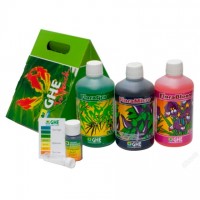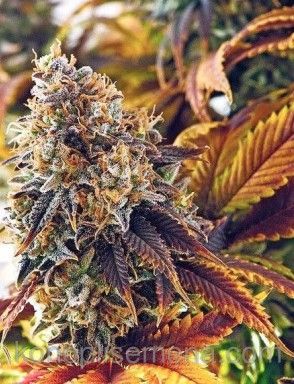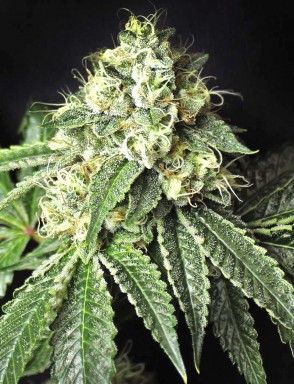Fertilizers
Bob Marley

A key factor to successfully growing healthy and productive cannabis is appropriate fertilizing. Like any living thing, cannabis needs nutrition. When it photosynthesizes, the chlorophyll in it releases energy that is used to assimilate (macro-/microelements) and build new cells.
In the absence of those elements, the plant slowly dies, eating itself, destroying its cells and producing them anew – a vicious circle, sooner or later leading to death. And what happens if the bush gets all the nutrients in the right amount? Then it is healthy, weighs a lot and produces essential oils, terpenes, saccharides and other values in abundance.
For a better view on this topic, let's get clear with some basic terminology.
- NPK is the proportion of nitrogen (N), phosphorus (P) and potassium (K) in fertilizer. On fertilizer packaging you will commonly find this ratio written, for example “NPK 12:12:6”.
- PPM (or EC) is the number of fertilizer particles dissolved in water. The higher the concentration of fertilizer in water, the higher the PPM value. Normally the packaging has a table showing the desired amount of PPM at each stage of growth.
Mineral and organic fertilizers – the difference
There are two types – organic and mineral fertilizers.Organic fertilizers are natural materials that come from living organisms or their decay products (manure, compost). These fertilizers enrich the soil with organic matter during decomposition and provide essential nutrients to plants.
In addition to macronutrients (nitrogen, phosphorus, potassium), hemp also consumes micronutrients – iron, magnesium, calcium, and so on. All these trace elements are quite important in equal proportions in the development of the plant. They are present in both organic fertilizers and mineral fertilizers, but in mineral fertilizers, you can monitor their exact amount.
Minuses of organic fertilizers:
- Strong specific odor;
- Slow reaction (takes a long time to release nutrients into the soil);
- May contain other seeds or fungi;
- Lower concentration of nutrients;
- Take up more volume (see point 4).
Pros of organics:
- Natural composition contributes to better cannabis flavor profiles;
- Resistance to soil changes;
- Supports microorganisms that form a symbiosis with the roots in the soil, helping them absorb more nutrients and even water;
- Smooth action compared to mineral fertilizers.
Mineral fertilizers for cannabis are chemical compounds that contain essential nutrients needed for plant growth and development. They are produced synthetically and can have different compositions. They usually contain nitrogen, phosphorus, potassium, and other trace elements necessary for optimal plant function.
Minuses:
- Risk of soil salinity – unabsorbed nutrients may build up, leading to an imbalance in the soil. As a result, some minerals will not be assimilated, while others will oversaturate the soil. The plant begins to show signs of nutrient deficiencies and overdoses.
- Less durable performance – unlike organic fertilizers, mineral fertilizers can provide temporary soil improvement but do not contribute to long-term soil enrichment because the minerals are released into soil instantly.
Pros:
- Quick action. Hemp has immediate access to nutrients after being watered with a solution of mineral fertilizer;
- Precise NPK composition (i.e., the proportion of nitrogen, phosphorus and potassium);
- High concentration of nutrients – more convenient to store and to apply than organic fertilizers;
- Controlled nutrient levels – accurately controlling the level of each nutrient allows to take into account the needs of cannabis at different stages of its life cycle;
- Applicability in a variety of conditions – suitable for different soil, substrate and climate types.
What’s the conclusion? Mineral fertilizers are often given preference by the breeders because of their simplicity and ease of handling.
Outdoor Cannabis: Fertilizing Specifics
Outdoor growing is considered a simpler and more efficient method. Space, sunlight and fresh air are in this case all provided in advance. Often the soil has the right pH level and macro/micronutrient composition (not always).
However, there may be specific difficulties: first, if the soil is poor in certain elements, it is necessary to select those fertilizers that compensate for this. Secondly, in arid regions, fertilizers that help improve water consumption are preferable (for example, potassium nitrate).
How Is Outdoor Cannabis Fertilized?
Fertilizers For Indoor Marijuana
Here the situation is somewhat simpler. Based on the above pros and cons of mineral and organic fertilizers, mineral fertilizers are the common choice for indoor cannabis. They give off less odor and are easier to handle store, and their amount is easier to calculate.
An indoor grow area is a more controllable environment. The composition and pH of the soil are known when you buy it – these data are indicated on the package. Whatever fertilizers are used, the most important thing is their quantity in the soil and their availability (i.e. the correct pH level – if this indicator deviates from the norm, the plant will not be able to use some elements for nutrition from the soil).
Fertilizers for Cannabis at Different Stages of Life
сAt each stage of growth, the desired proportion of nutrients changes: the need for some elements increases, while others are needed less. The cannabis life cycle is divided into 3 stages:
Vegetation, Flowering, and Maturation.
Vegetation
Nitrogen (N) supports the growth process and provides green mass for the plant. Phosphorus (P) is important for the development of stems, leaves, and overall energy supply. Potassium (K) promotes the formation of stronger and more stable stems.
In general, vegetative plants need nitrogen (N) the most, therefore an example of a suitable NPK is 24:6:12.
Flowering
A small amount of nitrogen supports overall growth, but most of the plant's green mass has already been formed. Phosphorus is critical for the formation of the flowers themselves (the so-called "buds") Potassium helps in strengthening the structure of the flower buds and provides energy for the flowering processes.
Potassium and phosphorus are the most wanted elements at this stage. Hence, aim for NPK 16:6:26 or something close.
Maturation
Nitrogen is the least necessary, because plants stop gaining green mass and give all their energy to the maturation of inflorescences. Phosphorus continues to support the ripening process and strengthening of the floral structure. Potassium, in its turn, is a key element for forming large, mature buds and providing the plant with energy. Potassium is also a component of ether oils, sugars, and terpenes.
Therefore, marijuana again is a big need of most phosphorus and potassium, but in a slightly different ratio (NPK 18:12:18).
How To Fertilize Marijuana?
Organic fertilizers are applied in advance, with the expectation that they will be completely released only in 2-3 weeks. Often they are immediately mixed with the soil, or mixed with its top layer, after which the spot is watered. As for mineral fertilizers, instructions are always provided by the vendor.
Which Cannabis Fertilizer Is Better – Organic or Mineral?
It is important to understand that experts and professionals make decisions based on the situation and personal experience.
However, the basic scheme is as follows:
Outdoor – a combination of organic and mineral fertilizers
Indoor – mineral fertilizers.
We hope that this article has helped you answer basic questions about which fertilizers are better for cannabis!
15.08.2016
Featured

 ru
ru ge
ge ua
ua


